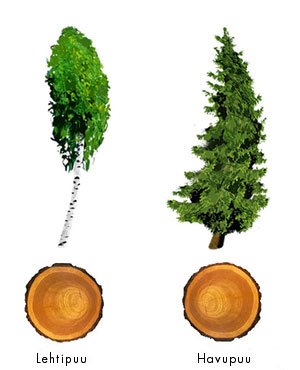Defects that have an impact on the strenght of the wood.
Branches
Branches weaken the wood because they are irregularities in the wood and their fibers are perpendicular to the tree itself.
Skewed fibers
Skewed fibers have a huge impact on the strength of the wood, even if the angle is small.
Young wood
The young wood is located in the core of the tree. Its density is low and that’s why it’s weaker than regular wood. The notable exception to this is the spruce, which has very dense young wood.
Reaction wood
Reaction wood is brittle when it’s dry, even if it grows stronger than regular wood.  When the trunk gets slanted for some reason, the tree tries to straighten up by growing reaction tree on one side of the trunk.
When the trunk gets slanted for some reason, the tree tries to straighten up by growing reaction tree on one side of the trunk.
The tree with reaction wood has an oval shaped trunk and the core is not in the center. The wood is very hard and its cellural structure is cyclic. This is why a tree with a lot of reaction wood will change its shape a lot after sawing. The reaction tree is a huge defect in lumber. Coniferous trees grow reaction wood to push the trunk into a straight up position and the deciduos trees grow to try pull the trunk to similar effect.
Micro-organisms
Some micro-organisms rot the tree. Common types of rot are white rot for deciduous trees and brown rot for coniferous trees. Fungi that make the trunk appear blue don’t have a direct impact on the strength of the treem but they are a sign that the tree might be rotten by other fungi.
Mold grows on the bark and thus has no effect on the wood itself.